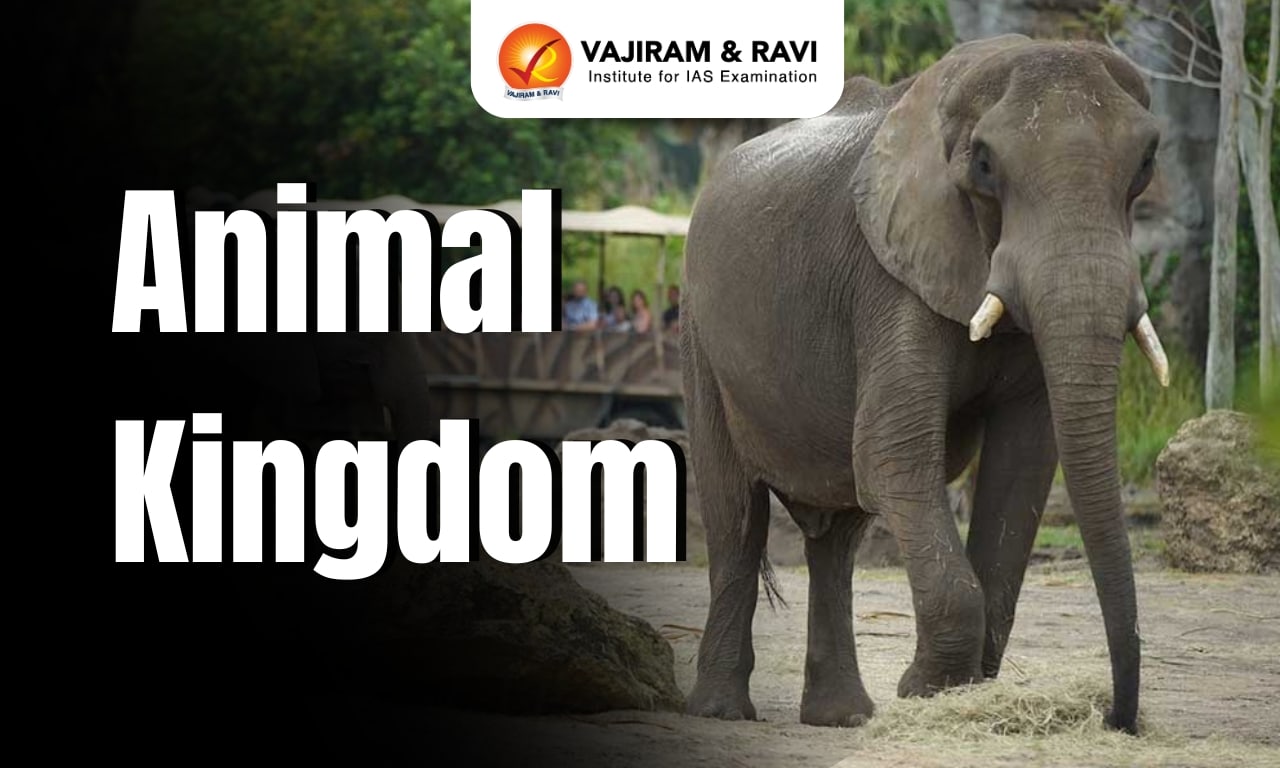Animalia is one of the five kingdoms of the living world. Animal kingdom can be broadly categorised according to a number of fundamental characteristics such as segmentation, notochord, coelom, symmetry, level of organisation, and cell organisation. In addition to the basic traits, each phylum or class has a variety of other unique characteristics.
As more than a million species of animals have been found so far, the need for classification and a proper taxonomy of these animals becomes important, which helps to assign a systematic position to any newly described species.
Basis of Classification
Though animals differ in their structure and form, there are some basic features that are common to individuals such as - arrangement of cells, body symmetry, coelom nature, digestive pattern, circulatory systems, respiratory systems, etc., which are taken together for the animal classification.
Levels of Organisation
Although all the members of Animalia are multicellular, they do not exhibit the same pattern in the organisation of cells. There are certain labour divisions (activities) within the cells.
- In coelenterates, the cell arrangement is more complex. Here, the cells performing the same function are arranged into tissues; hence, this is called the tissue level of organisation.
- A still higher level of organisation - organ level, is exhibited by members of Platyhelminthes and other higher phyla, where tissues are grouped together to form organs, each specialised for a particular function.
- In animals like Annelids, Arthropods, Molluscs, Echinoderms, and Chordates, organs are associated to form functional systems, each concerned with a specific physiological function. This pattern is called the organ system level of organisation.
- There are two possible types of circulatory systems:
- the open type: in which the blood is pumped out of the heart and the cells and tissues are directly bathed in it and
- a closed type: in which the blood is circulated through a series of vessels of varying diameters (arteries, veins and capillaries).
Symmetry
Animals can be categorised based on their symmetry.
- In asymmetrical animals, any plane that passes through the centre does not divide them into equal halves. Example: Sponges.
- It is called radial symmetry when any plane passing through the body's axis splits the organism into two identical halves.
- Examples: echinoderms, coelenterates, and ctenophores
- Other animals like annelids, arthropods, etc., in which the body can be divided into identical left and right halves in only one plane, exhibit bilateral symmetry.
Diploblastic and Triploblastic Organisation
- Diploblastic: These animals have two embryonic layers of cells, an internal endoderm and an external ectoderm.
- For example - coelenterates
- Triploblastic: In these animals, the developing embryo has a third germinal layer, the mesoderm, in between the ectoderm and endoderm.
- Examples: Platyhelminthes to chordates
Coelom
One of the very important bases of classification is the presence or absence of a cavity, called Coelom, which is present between the gut wall and the body wall.
- Animals possessing coelom are called coelomates.
- Examples- annelids, molluscs, arthropods, echinoderms, hemichordates and chordates
- In certain animals, the pseudo-coelom is found and the animals possessing it are called pseudocoelomates.
- Examples: Aschelminthes
- The animals in which the body cavity is absent are called acoelomates.
- For example- Platyhelminthes
Segmentation
In certain animals, the body is segmented both inside and outside, with at least some organs repeating serially.
- Despite having some type of serial repetition in their units, many taxa—such as the molluscs—are not typically thought of as segmented.
- Animals classified as segmented may have imitated organs or a body made up of self-similar units, but the term "segmented" usually refers to an organism's component parts.
- For example, in earthworms, the body shows a pattern called metameric segmentation and the phenomenon is known as metamerism.
Notochord
The notochord is a rod-like structure formed on the dorsal side at the time of embryonic development in certain animals.
- The animals that have notochord are known as chordates and those that do not have this structure are known as non-chordates
- For example- Porifera to Echinoderms
Classification of Animals
Based on the different classification factors discussed above, animals are classified into different phyla. The characteristics of these phyla and associated animals are described below.
| Phylum | Features | Examples |
| Porifera |
- Generally known as sponges - Primarily marine, asymmetric animal - Primitive multicellular - Possess water transport or canal system. - Exhibit Intracellular digestion - Sexes not separate (eggs and sperm are produced by the same individual). - Reproduction: both sexual (creating gametes) and asexual (fragmentation). |
- Sycon (Scypha), - Spongilla (Freshwater sponge) - Other examples: Euspongia |
| Coelenterata |
- These are aquatic, mostly marine, sessile or free-swimming, - Radially symmetrical. - The stinging capsules, or nematocysts, are found on the tentacles and body of the cnidoblasts or cnidocytes (source of the name cnidaria) - Cnidoblasts are used for defence, anchoring, and catching prey. - Cnidarians exhibit tissue-level organisation and are diploblastic. - They have a hypostomal mouth and a single-entry central gastro-vascular cavity. - Digestion is extracellular and intracellular. - Some cnidarians, such as corals, have a skeleton made up of calcium carbonate. - The two fundamental body forms that cnidarians display are polyps and medusa.
- Those cnidarians that exist in both forms exhibit alternation of generation (metagenesis), that is, polyps produce medusae asexually and medusae form the polyps sexually (example- Obelia). |
- Physalia (Portuguese man-of-war) - Adamsia (Sea anemone) - Other examples:
|
| Ctenophora (Cnidaria) |
- Generally known as sea walnuts or comb jellies. - These are exclusively marine, radially symmetrical, diploblastic organisms with tissue-level organisation. - Digestion is both extracellular and intracellular. - They exhibit bioluminescence, the ability to emit light. - Sexes are not separate. - only sexual reproduction. |
- Pleurobrachia - Ctenoplana |
| Platyhelminths |
- Have dorso-ventrally flattened bodies; hence, called flatworms - Are endoparasites, found in animals including human beings. - re bilaterally symmetrical, triploblastic and acoelomate animals with organ-level organisation. - Sexes are not separate. - Internal fertilisation occurs. - Certain members, such as Planaria, have a high capacity for regeneration. |
- Taenia (tapeworm) - Fasciola (liver fluke). |
| Aschelminthes |
- Known as roundworms because of their circular body cross-section. - Can be free-living or parasitic, aquatic orterrestrial or parasitic - organ-system level of body organisation - Bilaterally symmetrical, triploblastic and pseudocoelomate. - Sexes are separate (dioecious) - Often, females are longer than males. - Fertilisation is internal and development may be direct (the young ones resemble the adults) or indirect. |
- Ascaris (Roundworm) - Wuchereria (Filaria worm) - Ancylostoma (Hookworm) |
| Annelida |
- Both aquatic and terrestrial - free-living, sometimes parasitic. - organ-system level of body organisation - Bilateral symmetry - Triploblastic, metamerically segmented and coelomate animals - A closed circulatory system - Nephridia: Help in osmoregulation and excretion. - Reproduction is sexual. |
- Nereis - Pheretima (Earthworm) - Hirudinaria (blood-sucking leech) |
| Arthropoda |
- The largest phylum of Animalia, and includes insects. (More than two-thirds of all species on earth) - organ-system level of organisation. - These are
- The chitinous exoskeleton covers the arthropod body - The body is made up of a head, thorax and abdomen. - They have jointed appendages (arthros-joint, poda-appendages). - Respiratory organs include gills, book gills, and book lungs. - Open-type circulatory system. - Presence of sensory organs like antennae, eyes, and statocysts - Excretion takes place through malpighian tubules. - They are mostly dioecious. - Fertilisation is usually internal. - They are mostly oviparous. |
- Apis (Honey bee) - Bombyx (Silkworm) - Other examples:
|
| Mollusca |
- Second largest animal phylum - These are
- Body
- Mantle is made up of a soft and spongy layer of skin over the visceral hump. - Mantle cavity: The space between the hump and the mantle
- They have respiratory and excretory functions. - Sensory tentacles: at the anterior head - Radula: A file-like rasping organ for feeding in the mouth. - Usually dioecious and oviparous |
- Pila (Apple snail) - Pinctada (Pearl oyster) - Other examples:
|
| Echinodermata |
- Have an endoskeleton of calcareous ossicles, hence the name Echinodermata - Are:
- Have a complete digestive system - Distinctive features: the presence of a water vascular system, helping in locomotion, capture and transport of food and respiration. - excretory system is absent. - Sexes are separate. - Reproduction is sexual. - Fertilisation is usually external. |
- Asterias (Star fish) - Echinus (Sea urchin) -Other examples:
|
| Hemichordata |
- Contains stomochord, a structure similar to the notochord. - Have a small group of worm-like marine animals - organ-system level of organisation. - Bilaterally symmetrical, triploblastic and coelomate animals. - The body is cylindrical and is made up of an anterior proboscis, a collar and a long trunk. - Open-type circulatory system - Respiration through gills. - Sexes are separate. - Fertilisation is external. |
- Balanoglossus - Saccoglossus. |
| Chordata |
- Basically characterised by notochord presence, a dorsal hollow nerve cord and paired pharyngeal gill slits - Bilaterally symmetrical - Triploblastic, coelomate with organ-system level of organisation. - A closed circulatory system - Divided into three subphyla:
- Urochordata and Cephalochordata are known as protochordate and are exclusively marine. - Notochord presence:
|
- Urochordata – Ascidia, Salpa, Doliolum - Cephalochordata – Branchiostoma (Amphioxus or Lancelet). |
Classification and Characteristics of Vertebrata
The defining feature of this subphylum of chordata is the presence of a vertebral column (spine or backbone). The members of Vertebrates possess notochord during the embryonic period but it is replaced by the cartilaginous or bony vertebral column in adulthood.
- Thus, all vertebrates are chordates but not all chordates are vertebrates.
- Besides the basic chordate characters, vertebrates have a ventral muscular heart with two, three or four chambers, kidneys for excretion and osmoregulation, and paired appendages, which may be fins or limbs.
| Class | Features | Examples |
| Cyclostomata |
- All members of this class are ectoparasites living on some fish. - They have an elongated body with 6-15 pairs of gill slits for respiration. - They lack jaws and have a circular, sucking mouth. - The body does not consist of scales and paired fins. - The cranium and vertebral column are cartilaginous. - Closed type circulation - Marine but can migrate to freshwater for spawning. - After undergoing metamorphosis, their larvae return to the ocean. |
- Petromyzon (Lamprey) - Myxine (Hagfish). |
| Chondrichthyes |
- These are marine animals with streamlined bodies and a cartilaginous endoskeleton. - The mouth is located ventrally. - Notochord is persistent throughout life. - The gill slits are distinct and devoid of opercula. - Tough skin having minute placoid scales. - Teeth are modified placoid scales that are backwardly directed. - Their jaws are very powerful. - These animals are predaceous. - Due to the absence of an air bladder, they have to swim constantly to avoid sinking. - The heart is two-chambered (auricle and ventricle). - Some have electric organs (such as torpedoes) and some possess poison stings (such as trigon). - They are cold-blooded (poikilothermous) animals. - Sexes are separate. - They have internal fertilisation - Many of them are viviparous. |
- Scoliodon (Dogfish) - Pristis (Sawfish) - Other examples:
|
| Osteichthyes |
- Includes both marine and freshwater fish with bony endoskeletons. - Body is streamlined. - Mouth is mostly terminal - Possess four pairs of gills, each with an operculum covering them. - An air bladder is present and regulates buoyancy. - Heart is two-chambered (auricle and ventricle). - Cold-blooded animals. - Sexes are separate. - Fertilisation is usually external. - They are oviparous and development is direct. |
- Exocoetus (Flying fish) - Labeo (Rohu) - Other examples:
|
| Amphibia |
- In both aquatic and terrestrial habitats. - Most have two pairs of limbs. - The body can be separated into a head and a trunk. - Some have tails - Skin is moist (without scales). - The eyes have eyelids. - A tympanum represents the ear. - Alimentary canals, urinary and reproductive tracts open into a common chamber called the cloaca, which opens to the exterior. - Respiration is done by the gills, lungs and skin. - Heart with three chambers: one ventricle and two auricles. - Cold-blooded animals. - Sexes are separate. - Fertilisation is external. - Oviparous - Development is indirect. |
- Bufo (Toad) - Rana (Frog) - Other examples:
|
| Reptilia |
- creeping or crawling mode of locomotion. - Mostly terrestrial - Epidermal scales, scutes, or dry, cornified skin cover the body. - no external ear openings. - The tympanum represents the ear. - Limbs, when present, are two pairs. - three-chambered hearts (only crocodiles have four) - Scales are shed by snakes and lizards as skin casts. - Sexes are separate. - Fertilisation is internal. - Oviparous - Development is direct. |
- Chelone (Turtle) - Testudo (Tortoise) - Other examples:
|
| Aves (Birds) |
- Characteristic features
- The forelimbs are modified into wings. - Hind limbs generally have scales
- With the exception of the oil gland at the base of the tail, the skin is gland-free and dry. - Endoskeleton is fully ossified (bony) - Pneumatic bones (long, hollow, with air cavities), help in flying. - digestive tracts include extra chambers called the crop and gizzard (similar to the human stomach) - four-chambered heart - Warm-blooded - Respiration by the lungs. - Sexes are separate. - Fertilisation is internal. - Oviparous - Development is direct. |
- Corvus (Crow) - Columba (Pigeon) - Other examples:
|
| Mammalia |
- Found in different environments - Some have adapted to fly or live in water. - unique characteristic: the presence of milk-producing glands (mammary glands), by which the young ones are nourished - Possess two sets of limbs that are designed for different activities - Unique skin possessing hair - External ears - Different types of teeth in the jaw. - The heart is four-chambered. - Homoiothermous. - Respiration by the lungs - Sexes are separate - Fertilisation is internal. - Viviparous with few exceptions - Development is direct. |
- Platypus - Kangaroo - Other examples:
|
Last updated on November, 2025
→ Check out the latest UPSC Syllabus 2026 here.
→ Join Vajiram & Ravi’s Interview Guidance Programme for expert help to crack your final UPSC stage.
→ UPSC Mains Result 2025 is now out.
→ UPSC Notification 2026 is scheduled to be released on January 14, 2026.
→ UPSC Calendar 2026 is released on 15th May, 2025.
→ The UPSC Vacancy 2025 were released 1129, out of which 979 were for UPSC CSE and remaining 150 are for UPSC IFoS.
→ UPSC Prelims 2026 will be conducted on 24th May, 2026 & UPSC Mains 2026 will be conducted on 21st August 2026.
→ The UPSC Selection Process is of 3 stages-Prelims, Mains and Interview.
→ UPSC Result 2024 is released with latest UPSC Marksheet 2024. Check Now!
→ UPSC Prelims Result 2025 is out now for the CSE held on 25 May 2025.
→ UPSC Toppers List 2024 is released now. Shakti Dubey is UPSC AIR 1 2024 Topper.
→ UPSC Prelims Question Paper 2025 and Unofficial Prelims Answer Key 2025 are available now.
→ UPSC Mains Question Paper 2025 is out for Essay, GS 1, 2, 3 & GS 4.
→ UPSC Mains Indian Language Question Paper 2025 is now out.
→ UPSC Mains Optional Question Paper 2025 is now out.
→ Also check Best IAS Coaching in Delhi
Animal Kingdom FAQs
Q1. What is an animal kingdom?+
Q2. What is the basis of the classification of the animal kingdom?+
Q3. What is the meaning of phylum?+
Q4. How many phyla are there in the animal kingdom?+
Q5. What are vertebrates?What are vertebrates?+
Tags: animal kingdom quest






























































